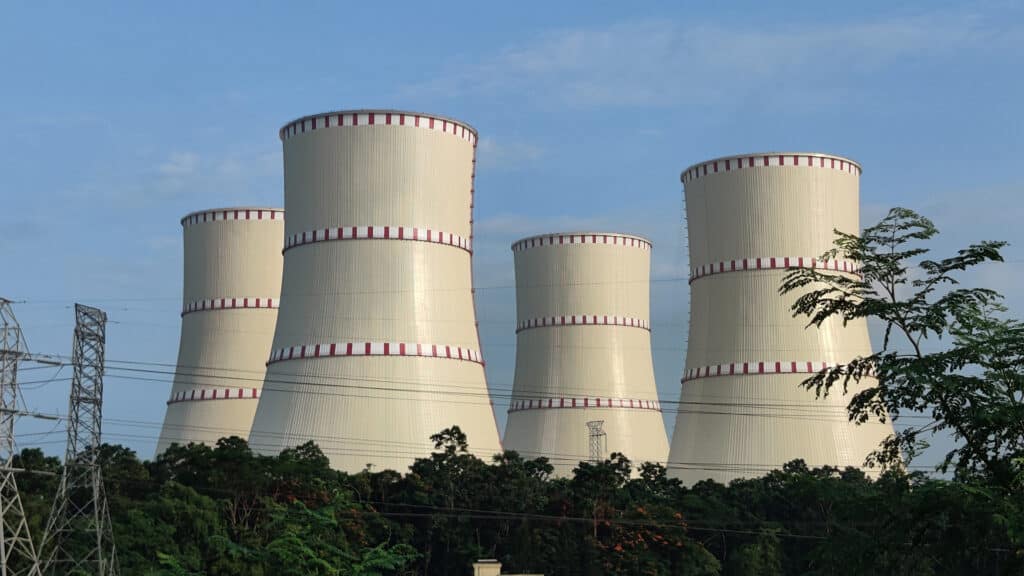
Kazakhstan will build its first nuclear power plant (NPP), with a capacity of 2.4 gigawatts (GW), using Russian export financing, according to the country’s Agency for Atomic Energy (AAE).
In mid-June 2025, Kazakhstan chose Russia’s state nuclear corporation Rosatom to lead the international consortium for constructing the plant, which will be located on the shores of Lake Balkhash.
EPC model
The project is expected to begin soon, as the Kazakh government has already committed to adding 2.4 GW of nuclear power capacity by 2035. The Ministry of Energy noted that construction, from pouring the foundation to launching the first reactor, could take eight to 14 years.
«Kazakhstan will implement its first NPP project using an EPC (engineering, procurement and construction) model, with Russia providing export financing under terms that are still being negotiated. The plant will be owned by a Kazakh company,» the AAE told Kursiv.media in response to an inquiry.
In March, Vice Minister of National Economy Arman Kassenov said financing could also come from export credit agencies and development institutions from other countries, including the U.S., China and Germany.
The estimated cost of the project is $14 billion. However, First Deputy Prime Minister Roman Sklyar acknowledged that the final price could rise by as much as 150% because of increasing costs for materials and services. The final cost will be determined upon completion of the design phase and passing the expert review.
International consortium
Rosatom has the option to select partner companies from a shortlist of technology providers previously considered to lead Kazakhstan’s first NPP project. Potential reactor suppliers include China’s CNNC with its HPR-1000 reactor, France’s EDF with the EPR1200 and South Korea’s KHNP with its APR-1000 and APR-1400 designs.
«All reactor technologies under consideration meet international safety standards, can withstand or be adapted to a maximum design earthquake of 9 on the seismic scale, feature active and passive safety systems, account for severe accidents and are equipped with a double containment structure,» the AAE said.
All shortlisted reactors are designed for a service life of 60 years.
The agency also noted that Rosatom is not currently subject to international sanctions. However, if sanctions risks emerge, Kazakhstan plans to use contractual safeguards similar to those applied in other projects, including sanctions clauses, to protect its interests during the plant’s construction.
On Jan. 8, 2025, President Kassym-Jomart Tokayev directed the cabinet to accelerate the construction of an NPP. He said two or three plants may ultimately be built to advance Kazakhstan’s nuclear energy sector.
China’s nuclear fuel
Russia’s Rosatom and China’s CNNC will consider establishing new elements of the nuclear fuel cycle in Kazakhstan, the AAE reported.
Although CNNC was not selected for Kazakhstan’s first NPP project, it was named the lead partner in an international consortium to build the country’s second plant.
«Russia, China and France are involved in all stages of the nuclear fuel cycle. At the same time, Russia and China are ready to explore the possibility of localizing certain stages of the cycle in Kazakhstan. We are also working on various options for international cooperation on specific stages of the nuclear fuel cycle with technology providers,» the AAE said.
Kazakhstan already plays a role in the fuel cycle. The Ulba Metallurgical Plant in Ust-Kamenogorsk — a subsidiary of Kazatomprom, the national nuclear company — produces uranium dioxide powders and tablets. Its affiliate, Ulba-TVS, manufactures fuel assemblies using French technology for Chinese NPPs. This gives Kazakhstan the ability to supply some of the materials needed for its own nuclear plants once they come online.
In late 2024, Kazatomprom CEO Meirzhan Yussupov said the company was in talks with foreign partners about the possibility of enriching uranium domestically. However, he acknowledged concerns among international stakeholders that a Kazakh enrichment facility could eventually produce weapons-grade uranium.
Conversion options
Regarding potential investment in uranium conversion — the process of turning uranium-containing materials into uranium hexafluoride, a key raw material for nuclear fuel production — Kazatomprom’s CEO noted that global conversion capacity has historically exceeded demand. Therefore, the payback period for such a project, previously estimated to cost between $1.1 billion and $1.2 billion, would likely be long.
The total cost of establishing both conversion and enrichment operations in Kazakhstan, including obtaining the necessary approvals from international regulators, could reach several billion dollars.
Kazakhstan extracts uranium through in-situ recovery or underground borehole leaching. Its primary output is uranium oxide, which serves as feedstock for conversion plants and ultimately for enrichment. Traditionally, Kazakhstan has sent its uranium to Russia for enrichment.
Kazakhstan also reportedly offered Turkey a uranium supply partnership to support Ankara’s growing nuclear energy ambitions. The proposal included granting Turkey a uranium mining contract in Kazakhstan and the option to participate in converting uranium-containing materials into uranium hexafluoride, with the potential to collaborate on later stages of the fuel cycle, such as fuel fabrication.
Baurzhan Ibrayev, a former Kazatomprom executive and now chairman of the Central Asia Advisory Board at the UK-based New Nuclear Watch Institute, believes Kazakhstan can develop the missing stages of the nuclear fuel cycle. He warned that failing to do so risks eroding the country’s position and expertise in the global nuclear market.


